
Silat Melayu, also known as Seni Persilatan Melayu or simply Silat, is a combative art of self-defence from the Malay world, that employs langkah ('steps') and jurus ('movements') to ward off or to strike assaults, either with or without weapons. Silat traced its origin to the early days of Malay civilisation, and has since developed into a fine tradition of physical and spiritual training that embodies aspects of traditional Malay attire, performing art and adat. The philosophical foundation of modern Malay Silat is largely based on the Islamic spirituality. Its moves and shapes are rooted from the basis of Silat movements called Bunga Silat, and Silat performances are normally accompanied with Malay drum assembles.
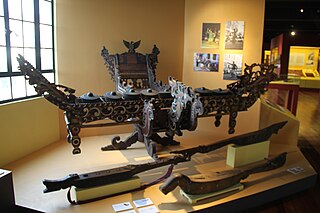
Kulintang is a modern term for an ancient instrumental form of music composed on a row of small, horizontally laid gongs that function melodically, accompanied by larger, suspended gongs and drums. As part of the larger gong-chime culture of Southeast Asia, kulintang music ensembles have been playing for many centuries in regions of the Southern Philippines, Eastern Malaysia, Eastern Indonesia, Brunei and Timor, Kulintang evolved from a simple native signaling tradition, and developed into its present form with the incorporation of knobbed gongs from Sundanese people in Java Island, Indonesia. Its importance stems from its association with the indigenous cultures that inhabited these islands prior to the influences of Hinduism, Buddhism, Islam, Christianity or the West, making kulintang the most developed tradition of Southeast Asian archaic gong-chime ensembles.
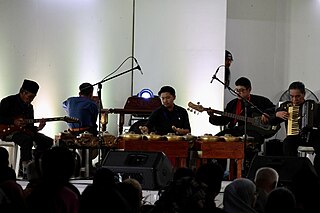
Brunei is a southeast Asian country located on Borneo between the states of Sabah and Sarawak which are part of Malaysia. There is a wide array of native folk music, and dance. Brunei shares some Cultural perspectives and links with the countries of South East Asia such as Malaysia, Singapore, Indonesia, Thailand, Philippines. The strong Islamic influence means that dance performances and music are somewhat restricted.

Dusun is the collective name of an indigenous ethnic group to the Malaysian state of Sabah of North Borneo. Collectively, they form the largest ethnic group in Sabah. The Dusun people have been internationally recognised as indigenous to Borneo since 2004 as per the United Nations Educational, Scientific and Cultural Organization (UNESCO).

The Kadazans are an ethnic group indigenous to the state of Sabah in Malaysia. They are found mainly in Penampang on the west coast of Sabah, the surrounding locales, and various locations in the interior.

The Momogun Rungus are an Austronesian ethnic group indigenous to Sabah, Malaysia. They primarily live in northern Sabah especially in Kudat Peninsula, Kota Marudu, Pitas and Beluran. A sub-group of the Kadazan-Dusun, they have a distinct language, dress, architecture, customs, and oral literature from other Dusunic sub-groups. There are around 74,000 Rungus people in the state.

Kadazan-Dusun are an amalgamation of the two closely related indigenous peoples in Sabah, Malaysia that is Kadazan and Dusun people. The Kadazandusun is the largest ethnic group in the state. They are also known as Mamasok Sabah, meaning "indigenous people of Sabah". The traditional worldview according to Kadazan-Dusun tradition mentiones that they are the descendants of Nunuk Ragang. Kadazan-Dusun is recognised as an indigenous nation of Borneo with documented heritage by the United Nations Educational, Scientific and Cultural Organization (UNESCO) since 2004. Kadazan-Dusun is part of bumiputera group in Malaysia and has its own special rights from land rights, rivers, education and maintaining their own customs.

The agung is a set of two wide-rimmed, vertically suspended gongs used by the Maguindanao, Maranao, Sama-Bajau and Tausug people of the Philippines as a supportive instrument in kulintang ensembles. The agung is also ubiquitous among other groups found in Palawan, Panay, Mindoro, Mindanao, Sabah, Sulawesi, Sarawak and Kalimantan as an integral part of the agung orchestra.
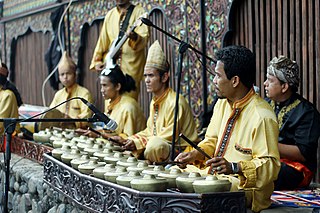
Talempong is a traditional music of the Minangkabau people of Western Sumatra, Indonesia. The talempong produce a static texture consisting of interlocking rhythms.
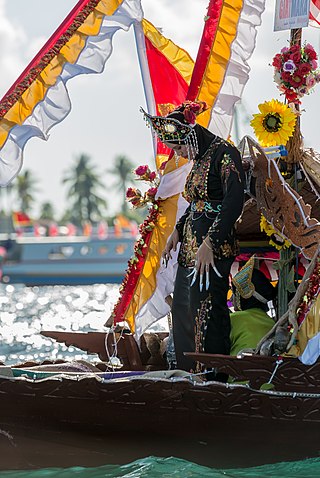
Pangalay is the traditional "fingernail" dance of the Tausūg people of the Sulu Archipelago and eastern coast Bajau of Sabah.
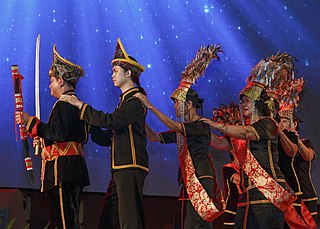
Kaamatan or Pesta Kaamatan is a form of harvest festival celebrated on 30 and 31 of May annually in the state of Sabah and Federal Territory of Labuan in Malaysia. It is normally celebrated by the ethnic Kadazan-Dusuns, as well as by other related ethnic groups in the state, and lasts for the whole of the month of May, ending with a public holiday on a date selected by a priestess known as the bobohizan.

Pakaian is the term for clothing in Malaysia's national language. It is referring to things to wear such as shirts, pants, shoes etc. Since Malaysia is a multicultural nation: Malay, Chinese, Indian and hundreds of other indigenous groups of Malay peninsula and Borneo, each has its own traditional and religious articles of clothing all of which are gender-specific and may be adapted to local influences and conditions. Previously, traditional clothes were worn daily. However, by excluding Baju Melayu, Baju Kurung many are now only worn on special occasions such as marriage ceremonies and cultural events.

The Malay Gamelan is a style of music originated from Indonesia, performed in ethnic Malay-populated regions of Indonesia and Malaysia as well.
Central Dusun, also known as Bunduliwan, is an Austronesian language and one of the more widespread languages spoken by the Dusun peoples of Sabah, Malaysia.

Sabah is the third most populous state in Malaysia, with a population of 3,418,785 according to the 2020 Malaysian census. It also has the highest non-citizen population, at 810,443. Although Malaysia is one of the least densely populated countries in Asia, Sabah is particularly sparsely populated. Most of the population is concentrated along coastal areas, with towns and urban centers seeing the most population growth.
Shafirul Azmi bin Suhaimi Jawi شافيرول عزمي سوهايمي is a Malaysian citizen born in Sabah. He is one of the famous contemporary dance choreographers in the country. The basis of his dance moves was greatly influenced by the martial arts called Silat, a gesture of Sabah and Sarawak traditions that made his choreography very unique and interesting. In addition, he has often adopted site-specific, post-modern ideologies in his work.

A tifa totobuang is a music ensemble from the Maluku Islands, related to the kulintang orchestra. It consists of a set of a double row of gong chimes known as the totobuang and a set of tifa drums. It can also include a large gong.

Music of Minang is a traditional and living genre of Indonesian music that grows and develops in the Minangkabau culture area. Music whose origins are related to Malay Music is generally played by musical instruments such as Talempong, Saluang, Minang rebab, Serunai, Tmbourine, Aguang, Gandang, and Violin. Minang music is also played to accompany various dances such as the Pasambahan dance and the Piring dance.
Cinta Sayang is a traditional Malay dance originated from the state of Kedah in northern Peninsular Malaysia. The dance is popular amongst Kedah Malays as an opening dance for important events.



















